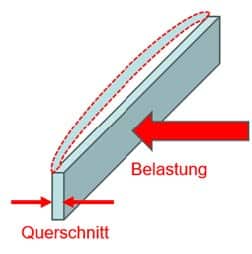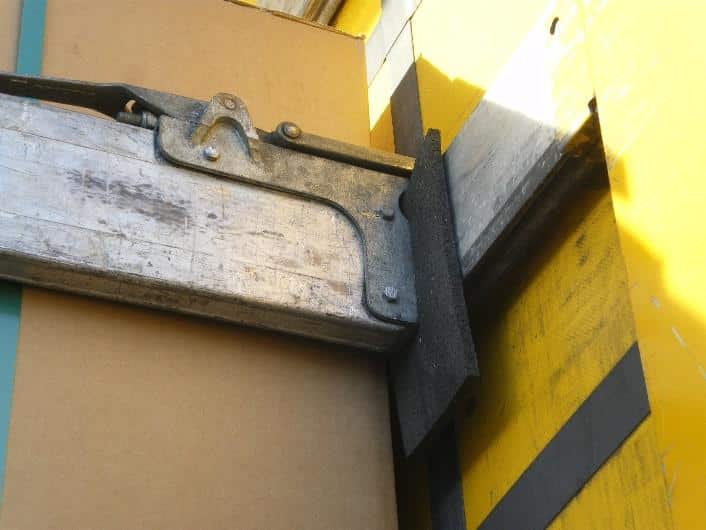
Now 10% off all Ergolash lashing straps save now! Voucher code: ergo10 | Valid until 31.05.2025
The functionality and effectiveness of load securing depends to a large extent on the securing equipment used. Unfortunately, this often leaves a lot to be desired. The causes are mainly to be found in the following areas:
There are two modes of action for locking devices, namely force-fit and form-fit.
The fact that the introduction of the Code XL standard means that much better vehicles are available leads some drivers and shippers to believe that they no longer need to do anything. The Code XL standard is only fully applicable when the vehicle is fully loaded. In other words, the load must fit snugly against the bulkhead, the load width must not be less than 2.40 m across the entire loading area and the distance to the rear portal must be less than 15 cm.
However, this is the case with very few transports. In most cases, the strength of the rear portal according to Code XL cannot be used because the load is more than 15 cm away from it. The truck is more likely to be too heavy before it is fully loaded.
A key factor is the fact that means of transportation are offered without safety equipment. The buyer has to purchase them additionally and the costs of systemic security devices that match the means of transportation are often saved. As a result of this necessity, safety equipment is later purchased or taken over from other vehicles.
This can be seen, for example, from the fact that a box van has a combination anchor rail on both sides, which is designed for form-fit securing devices, but clamping rods are actually used. This means that the securing force is far below what is possible.
A typical picture for incorrect equipment. A refrigerated box body in which the load is secured with clamping rods. Regardless of which load is stowed, the requirement for securing 0.5 g to the rear cannot be met in this way. The truck is designed for full loads, but not for partial loads on the return journey.

The size of the load securing forces required depends on the permissible total weight. The Code XL standard requires that the rear portal must hold 30% of the payload. This can serve as a guide for the amount of securing equipment. Example: If a semi-trailer (technical payload 27,000 kg) is loaded with 20,000 kg and the load is more than 15 cm away from the front wall, a securing force of 6,000 daN would be required at the rear.
If commercially available clamping boards (intermediate wall fasteners) with a securing force of 400daN are used, 15 would be required. The majority of trucks are equipped with 2-3 units. If the truck were to be equipped with steel insertion slats or combination anchor rails and locking beams with 4,000 to 4,500daN each were used, two would be required.
Clamping boards and clamping rods are designed in such a way that they must be loaded along their entire length. It is not uncommon for the truck to be loaded in such a way that there is a single pallet in the last loading row. The securing device is then positioned behind it.
The picture on the right shows the best method for damaging clipboards. Irrespective of this, the securing force is not sufficient for the entire load. In the best case, this would be 2x400daN. Incorrect use reduces this value considerably.

Even as-new clamping boards have a maximum securing force of 400daN if they are loaded across their entire width.

In this loading situation, an attempt is made to secure a load weighing approx. 17 tons to the rear with three belts. Two of these (yellow) result in a head lashing with a reduced effect and one (red) represents a tie-down lashing.
Assuming that the friction on the loading surface is μ=0.3, a securing force of approx. 3,400daN would be required.

With the correct pre-tensioning force, the tie-down lashing would bend the frame of the IBC. The blue belt would damage the insertion slats by pulling them inwards. The head flashing with the gray belt could slip off the edge when riding and the belt would be loose. Overall, everything is uncertain. It would also be better overall to stow the individual IBC in the loading row in front of it in order to have a complete loading row at the end.
Securing devices with the word “clamps” in their name always act on friction, i.e. they are friction-locked. Those containing the word “lock” have a form-fitting effect. Unfortunately, the technical condition often leaves a lot to be desired.
This adjustment screw is used to adjust the locking mechanism, which ultimately generates the securing force, to the thickness of the insertion bar in order to achieve the highest possible clamping force/friction force.


However, if the hinge pin is replaced by a wooden dowel, everything is ineffective.

Compensating for the excessively thin insertion plate with an old license plate shows a lack of knowledge about the mechanism of action. The adjustment screw is intended for precisely this case.

Welding a tubular bar to the defective clamping devices of a clamping board is a lot of work. Nothing is for nothing, it can still serve as a bad example. Nothing has been done to the two jaws where the actual clamping effect is generated. The question of the securing force is useless because the inspection authorities will judge this part to be ineffective.

Clamping one anti-slip mat into the mechanism is a good approach, but can only be a temporary emergency solution because the securing force is not known. The counterpart is missing on the other side.


Both the driver and the responsible shipper believe that they are safe when in fact they are not.
Clamping beams work on the same principle, but are not as sensitive to point loading.


The securing force for flat loads is between 800 and 1,000daN.

Clamping rods are also based on the friction principle. When the second pole was clamped, the first one fell over because the roof lifted. When the driver inserted the third one, the first two fell over. All three poles only hold enough to prevent them from falling over on their own. They do not have a load-securing effect.

In general, the securing force of clamping rods is a maximum of 150daN for flat loads. This means that they are actually only suitable for vans, but not for vehicles over 12 tons GVW.


Barrier bar systems are much more effective. However, they are typical for the manufacturer and are not interchangeable in parts.
The manufacturer specifies a blocking force BC of up to 4,100daN per beam for this locking beam system.

This extract from the Code XL certificate of a SchmitzCargobull semi-trailer shows the boundary conditions under which the locking beams achieve their maximum effect.

Very often these boundary conditions are not met. For example, the coefficient of friction of μ=0.3 is not given if the loading area has not been swept clean.
An improved version of this system achieves 4,500daN per beam. This also allows a load to be secured to the front if it cannot be positioned against the bulkhead due to the load distribution.

Yours, Sigurd Ehringer
<< Previous Post
Episode 42: Wedges for load securing

Sigurd Ehringer
✔ VDI-zertifizierter Ausbilder für Ladungssicherung ✔ Fachbuch-Autor ✔ 8 Jahre Projektmanager ✔ 12 Jahre bei der Bundeswehr (Kompaniechef) ✔ 20 Jahre Vertriebserfahrung ✔ seit 1996 Berater/Ausbilder in der Logistik ✔ 44 Jahre Ausbilder/Trainer in verschiedenen Bereichen —> In einer Reihe von Fachbeiträgen aus der Praxis, zu Themen rund um den Container und LKW, erhalten Sie Profiwissen aus erster Hand. Wie sichert man Ladung korrekt und was sind die Grundlagen der Ladungssicherung? Erarbeitet und vorgestellt werden sie von Sigurd Ehringer, Inhaber von SE-LogCon.
Rothschenk assortment
Our customer center has only one goal: to turn your problems into solutions. Whether standard stowage cushions, bestsellers or load securing personally tailored to your needs -. we accompany you consistently from A as in field service to Z as in certification. That is our promise to you, as a leader in our industry.
We attach great importance to professional cargo securing. That is why we have our own production, which ensures reliable operation through modern manufacturing technologies and strict quality control. Thus, we offer our customers a comprehensive and high-quality range of services in the field of transport logistics.
DIN ISO 9001:2015, EMAS and Ecovadis are not foreign words to you? Then it's time to work with the best.
You don't take any risks with us - we have been awarded the Platinum Medal on the EcoVadis sustainability rating platform.
As a load securement company, we are proud to have several certifications that validate our sustainability efforts and our commitment to environmental protection and social responsibility. For you as a purchaser, this means that we demand and promote the implementation of high environmental and social standards both within the company and along the supply chain.
You are currently viewing a placeholder content from Google Maps. To access the actual content, click the button below. Please note that doing so will share data with third-party providers.
More Information